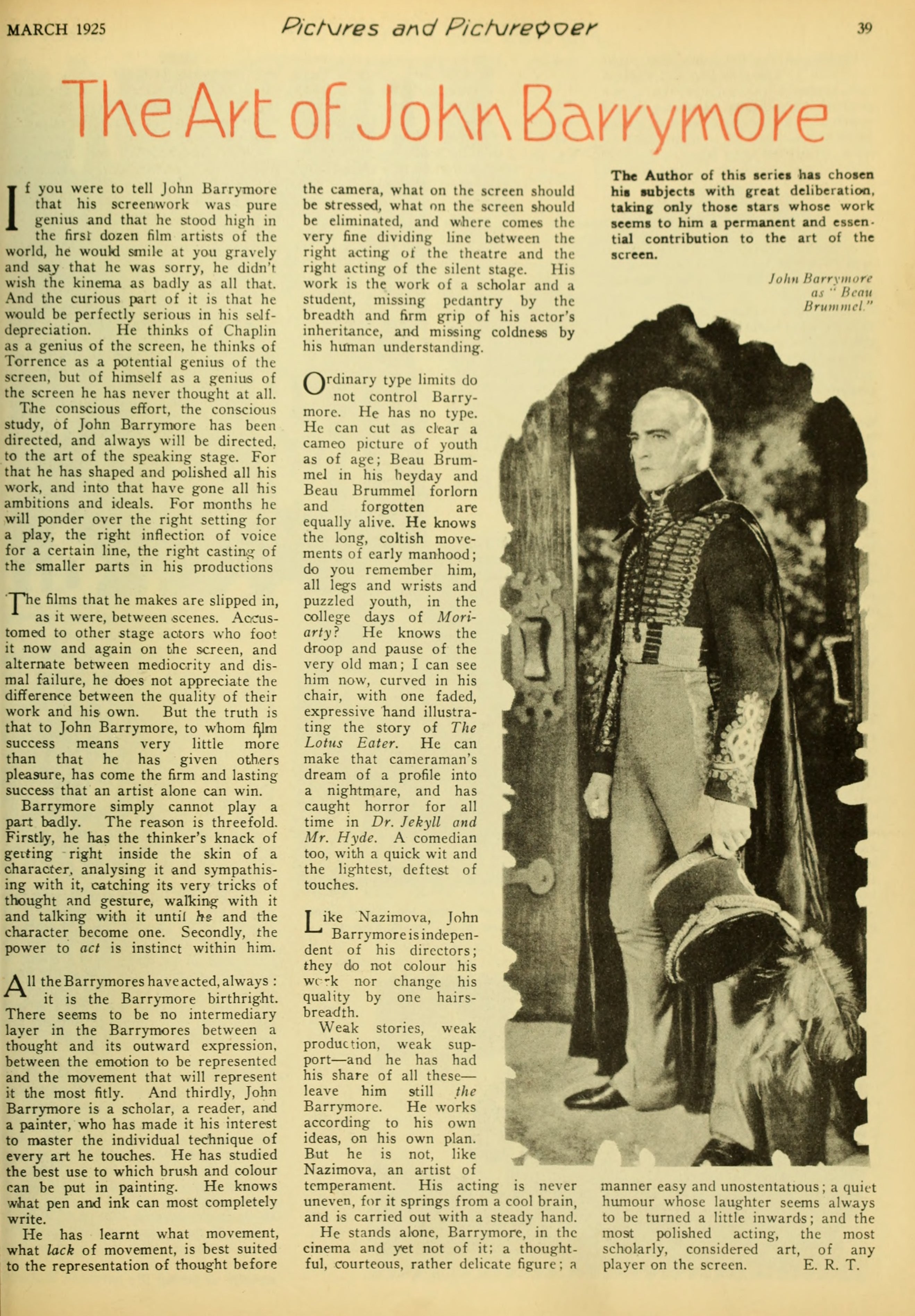The Art of John Barrymore (1925) 🇬🇧

If you were to tell John Barrymore that his screenwork was pure genius and that he stood high in the first dozen film artists of tin-world, he would smile at you gravely and say that he was sorry, he didn’t wish the kinema as badly as all that. And the curious part of it is that he would be perfectly serious in his self-depreciation.
by E. R. Thompson
He thinks of Chaplin [Charles Chaplin] as a genius of the screen, he thinks of Torrence [Ernest Torrence] as a potential genius of the screen, but of himself as a genius of the screen he has never thought at all. The conscious effort, the conscious study, of John Barrymore has been directed, and always will be directed. to the art of the speaking stage. For that he has shaped and polished all his work, and into that have gone all his ambitions and ideals. For months he will ponder over the right setting for a play, the right inflection of voice for a certain line, the right casting of the smaller parts in his productions.
The films that he makes are slipped in, as it were, between scenes. Accustomed to other stage actors who foot it now and again on the screen, and alternate between mediocrity and dismal failure, he does not appreciate the difference between the quality of their work and his own. But the truth is that to John Barrymore, to whom film success means very little more than that he has given others pleasure, has come the firm and lasting success that an artist alone can win.
Barrymore simply cannot play a part badly. The reason is threefold. Firstly, he has the thinker’s knack of getting right inside the skin of a character, analysing it and sympathising with it, catching its very tricks of thought and gesture, walking with it and talking with it until he and the character become one. Secondly, the power to act is instinct within him.
All the Barrymores have acted, always: it is the Barrymore birthright. There seems to be no intermediary layer in the Barrymores between a thought and its outward expression, between the emotion to be represented and the movement that will represent it the most fitly. And thirdly, John Barrymore is a scholar, a reader, and a painter, who has made it his interest to master the individual technique of every art he touches. He has studied the best use to which brush and colour can be put in painting. He knows what pen and ink can most completely write.
He has learnt what movement, what lack of movement, is best suited to the representation of thought before the camera, what on the screen should be stressed, what on the screen should be eliminated, and where comes the very fine dividing line between the right acting of the theatre and the right acting of the silent stage. His work is the work of a scholar and a student, missing pedantry by the breadth and firm grip of his actor’s inheritance, and missing coldness by his human understanding.
Ordinary type limits do not control Barrymore. He has no type. He can cut as clear a cameo picture of youth as of age; Beau Brummel in his heyday and Beau Brummel forlorn and forgotten are equally alive. He knows the long, coltish movements of early manhood; do you remember him, all legs and wrists and puzzled youth, in the college days of Moriarty? He knows the droop and pause of the very old man; I can see him now, curved in his chair, with one faded, expressive hand illustrating the story of The Lotus Eater. He can make that cameraman’s dream of a profile into a nightmare, and has caught horror for all time in Dr. Jekyll and Mr. Hyde. A comedian too, with a quick wit and the lightest, deftest of touches.
Like Nazimova [Alla Nazimova], John Barrymore is independent of his directors; they do not colour his work nor change his quality by one hairs-breadth.
Weak stories, weak production, weak support — and he has had his share of all these — leave him still the Barrymore. He works according to his own ideas, on his own plan. But he is not, like Nazimova, an artist of temperament. His acting is never uneven, for it springs from a cool brain, and is carried out with a steady hand. He stands alone, Barrymore. in the cinema and yet not of it; a thoughtful, courteous, rather delicate figure; a manner easy and unostentatious; a quiet humour whose laughter seems always to be turned a little inwards; and the most polished acting, the most scholarly, considered art, of any player on the screen.

John Barrymore as Beau Brummel
Collection: Picturegoer Magazine, March 1925
---
The Art of… series:
- 1925–01 — Alla Nazimova
- 1925–02 — Adolphe Menjou
- 1925–03 — John Barrymore
- 1925–04 — Charles Chaplin
- 1925–05 — Pola Negri
- 1925–06 — Douglas Fairbanks Sr.
- 1925–07 — Leatrice Joy
- 1925–08 — Bernhard Goetzke
- 1925–09 — Mary Pickford
- 1925–10 — Ernst Lubitsch
- 1925–12 — Ian Keith
